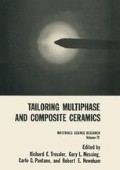Abstract
Contact angles between silicon and a variety of silicon carbide-based fibers have been measured and correlated to the mechanical behavior of the fiber-matrix interface. Infiltration by the molten silicon into the fibers and/or reaction with excess carbon to form silicon carbide gives rise to low contact angles and high toughness interfaces. It is suggested that the high toughness of the interface is morphology-controlled.
Access this chapter
Tax calculation will be finalised at checkout
Purchases are for personal use only
Preview
Unable to display preview. Download preview PDF.
References
R. M. Cannon, Factors Controlling Interfacial Bond Strengths of Ceramic-Metal Interfaces, 87th Meeting of the American Ceramic Society, Cincinnati, OH, 1985.
J. T. Klomp, Sci. Ceram. 5: 501 (1970).
L. E. Murr, Interfacial Energetics in Metal-Metal, Metal-Ceramic, Metal-Semiconductor, and Related Solid-Solid and Liquid-Solid Systems in: “Surfaces and Interfaces in Ceramic-Metal Systems” J. A. Pask and A. G. Evans, eds. Plenum Press, New York (1981).
M. Humenik, Jr. and W. D. Kingery, Metal-Ceramic Interactions: III, J. Amer. Ceram. Soc. 37 [1] 18 (1954).
N. Eustathopoulos, Energetics of Solid/Liquid Interfaces of Metals and Alloys, Int. Met. Rev. 28 [4] 189 (1983).
W. D. Kingery and M. Humenik, Jr., Surface Tensions at Elevated Temperatures, I, J. Phys. Chem. 57: 359 (1953).
W. D. Kingery, Metal-Ceramic Interactions: IV, J. Amer. Ceram. Soc. 37 [2] 42 (1954).
B. C. Allen and W. D. Kingery, Surface Tension and Contact Angles in Some Liquid Metal-Solid Ceramic Systems at Elevated Temperatures, Trans. Met. Soc. AIME 215 [23 30 (1959).
G. L. Mack, The Determination of Contact Angles from Measurements of Dimensions of Small Bubbles and Drops I: The Spheroidal Segment Method for Acute Angles and II: The Sessile Drop Method for Obtuse Angles, J. Phys. Chem. 40 [2] 159 (1936).
D. B. Marshall, An Indentation Method for Measuring Matrix-Fiber Frictional Stresses in Ceramic Composites, J. Amer. Ceram. Soc. 67 [12] C259 (1984).
P. Dokko and A. G. Evans, unpublished work.
G. R. Anstis, P. Chantikul, B. R. Lawn and D. B. Marshall, A Critical Evaluation of Indentation Techniques for Measuring Fracture Toughness: I, J. Amer. Ceram. Soc. 64 [9] 533 (1981).
J. W. Patterson, Conduction Domains for Solid Electrolytes, J. Electrochem. Soc. 3 [7] 1033 (1971).
P. Deines et al., Temperature-Oxygen Fugacity Tables for Selected Gas Mixtures in the System C-H-O at One Atmosphere Total Pressure, Bull Earth and Min. EXP . Sta. Penn. State Univ. 88: (1974).
T. J. Whalen and A. T. Anderson, Wetting of SiC, Si3N4, and Carbon by Si and Binary Si Alloys, J. Amer. Ceram. Soc. 50 [9–10] 396 (1975).
Y. V. Naidich and G. M. Nevodnik, Wettability of the Surface of SiC Single Crystals by Molten Metals, Izv. Akad. Nauk SSSR Neorg. Mat 5 [12] 2066 (1969).
W. P. Minnear, The Reaction of Carbon with Liquid Silicon, 14th Biennial Conference on Carbon, Pennsylvania State University, 1979.
W. P. Minnear, Interfacial Energies in the Si/SiC System and the Si+C Reaction, J. Amer. Ceram. Soc. 65 [1] C10 (1982).
K. T. Faber and A. G. Evans, Crack Deflection Processes — I, Acta Metall. 31 [4] 565 (1983).
Author information
Authors and Affiliations
Editor information
Editors and Affiliations
Rights and permissions
Copyright information
© 1986 Plenum Press, New York
About this chapter
Cite this chapter
Godard, H.T., Faber, K.T. (1986). Surface Energy as an Indicator of Interfacial Mechanical Response. In: Tressler, R.E., Messing, G.L., Pantano, C.G., Newnham, R.E. (eds) Tailoring Multiphase and Composite Ceramics. Springer, Boston, MA. https://doi.org/10.1007/978-1-4613-2233-7_54
Download citation
DOI: https://doi.org/10.1007/978-1-4613-2233-7_54
Publisher Name: Springer, Boston, MA
Print ISBN: 978-1-4612-9309-5
Online ISBN: 978-1-4613-2233-7
eBook Packages: Springer Book Archive

